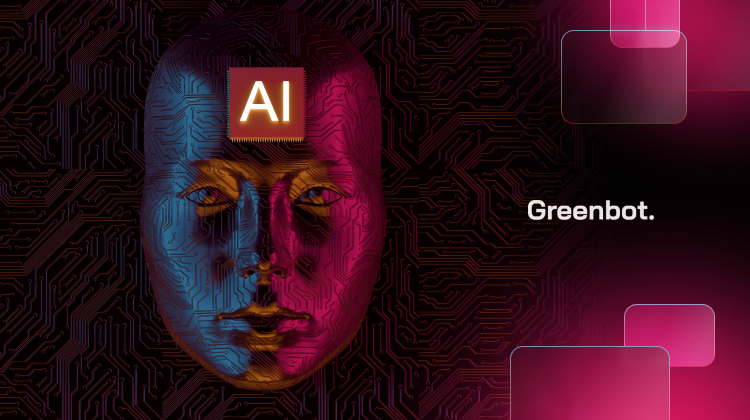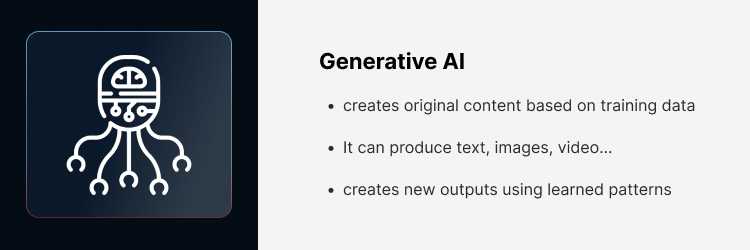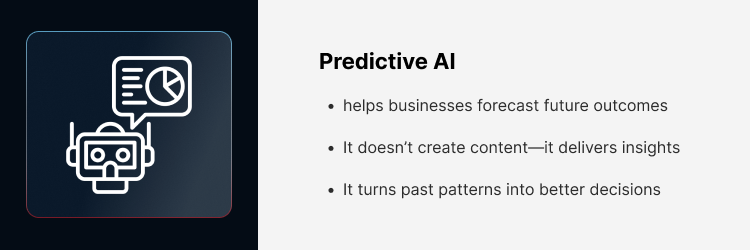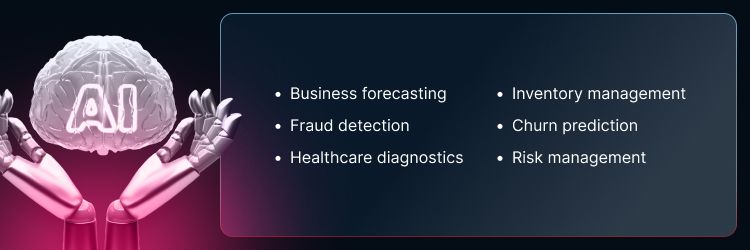
AI tools like ChatGPT, DALL·E, and GitHub Copilot may feel predictive—but they’re not. These are generative AI tools designed to create content, not forecast outcomes.
Generative AI and predictive AI are two branches of artificial intelligence. One generates new outputs from patterns. The other analyzes trends to predict future events.
Both types of AI tools solve problems, just in different ways. This article explains how they work, what sets them apart, and how they complement each other in real-world use.
What Is Generative AI?

Generative AI creates original content based on training data and your input. It can produce text, images, video, audio, or code—depending on the task.
Unlike tools that retrieve or summarize, generative AI creates new outputs using learned patterns. It’s used for content generation, design, education, and creative work.
It relies on generative models trained to respond with fresh, personalized results. This makes it ideal for text generation, design prototyping, or brainstorming ideas across industries.
How Do Generative AI Models Work?
Generative AI models don’t copy—they learn patterns through training data and complex math. These models are built using deep neural networks that improve with every training cycle.
Two powerful model types lead the field: generative adversarial networks (GANs) and diffusion models. Both power today’s most advanced visual and text tools.
GANs have two parts: a generator that creates content, and a discriminator that checks its quality. The system improves through constant feedback between the two.
Diffusion models start with noise and refine it until a clear result appears. These models shine in image generation, thanks to their realistic detail.
Generative AI Applications in the Real World
Here’s how generative AI applications are used across industries:
- Content creation: Blogs, ads, and social media posts created in seconds
- Brainstorming: Fast idea generation for creative teams
- Educational tools: AI-written essays, quizzes, and study material
- Code generation: AI is now generating code, scripts, and automation
- Data augmentation: AI expands datasets to train better models
What Is Predictive AI?
Predictive AI helps businesses forecast future outcomes by spotting trends in historical data. It doesn’t create content—it delivers insights.
Its main goal is to predict future outcomes so teams can plan smarter and reduce risk. It turns past patterns into better decisions.
How Do Predictive AI Models Work?
Predictive AI models analyze input data to find patterns and make forecasts. They use training data like customer behavior, logs, or purchase history.
Cleaned data is split into learning and test sets. Statistical algorithms and machine learning improve the model’s accuracy over time.
Predictive models are more explainable, helping businesses trust the output. This makes predictive AI perfect for data-backed decision-making.
Predictive AI Applications You Should Know
These real-world predictive AI applications show up in everyday business:
- Business forecasting: Predict sales, demand, and market shifts
- Fraud detection: Spot suspicious patterns early
- Healthcare diagnostics: Detect diseases sooner, improve patient care
- Inventory management: Optimize stock and delivery planning
- Churn prediction: Flag customers likely to leave, boost retention
- Risk management: Forecast problems before they escalate
Key Differences Between Generative and Predictive AI
The debate of generative AI vs predictive AI comes down to one thing: creation versus prediction. Both solve problems differently, depending on your goals and the kind of data you have.
Here’s a quick look at the key differences:
| Feature | Generative AI | Predictive AI |
| Purpose | To create new content | To forecast future outcomes |
| Data Used | Trained on existing content and patterns | Based on historical data and trends |
| Outputs | Text, images, video, audio, and code | Probabilities, scores, forecasts |
| Explainability | Often less transparent, harder to trace | More explainable due to statistical basis |
| Industries Used | Marketing, education, design, media | Finance, healthcare, logistics, customer service |
Is ChatGPT Generative or Predictive AI?
ChatGPT is a popular example of a generative AI tool. It creates human-like text by predicting the next word based on user input, but its goal isn’t to forecast the future—it’s to generate full, coherent responses.
It uses a Generative Pre-Trained Transformer (GPT) model trained on diverse data to power real-time conversations. Unlike predictive AI, ChatGPT’s focus is on content generation, not future trends or data forecasts.
Why Businesses Use Predictive AI
Predictive AI solutions help companies make faster, smarter decisions. By spotting patterns in historical data, predictive AI makes predictions that guide strategy, minimize risk, and increase efficiency across business operations.
- Forecasting trends: Project sales and plan demand with more accuracy
- Making data-driven decisions: Replace gut instincts with real insights
- Enhancing customer experience: Personalize messaging, support, and offers
- Preventing fraud: Detect suspicious behavior early
- Improving operations: Streamline logistics and reduce costly delays
Why Businesses Use Generative AI
Generative AI is changing how companies write, build, and brainstorm. It boosts speed, cuts costs, and powers scalable content generation and creative processes across departments.
- Content marketing: Quickly produce blog posts, ads, and product copy
- Code generation: Write and test code with fewer bugs
- Design prototyping: Create fast mockups and visuals for UX
- Custom marketing material: Generate emails, offers, and reports
- Creative idea generation: Kickstart campaigns with fresh content and copy
Pros and Cons of Generative AI
Pros
- Fast, scalable content creation across industries
- Sparks creativity with fresh ideas and formats
- Adapts output to tone, audience, and intent
- Cuts down manual workload
- Supports branding at scale
Cons
- Generative AI lacks explainability—its logic isn’t always clear
- Can unintentionally mimic copyrighted work
- Not all results are accurate or reliable
Pros and Cons of Predictive AI
Pros
- Predictive AI focuses on actionable insights
- Delivers accurate predictions with strong data
- Supports business planning and performance tracking
- Helps with risk management and fraud prevention
- Improves customer retention through smarter targeting
Cons
- Results depend on high quality data
- Bias in data can distort outcomes
- Needs oversight to avoid unintended consequences
When to Use Predictive AI
Choose predictive AI when success depends on knowing what’s coming. It works best for data-heavy decisions that need speed and precision.
- Retail planning: Predict product demand and avoid overstock
- Investment strategies: Analyze trends and adjust portfolios
- Health monitoring: Spot early warning signs and improve care
When to Use Generative AI
Generative AI creates content quickly and at scale. It’s best for use cases that involve idea development, writing, visuals, or learning support.
- Product descriptions: Write thousands in consistent tone and format
- Ad creatives: Produce campaign copy variations in minutes
- Educational tools: Build quizzes, lessons, and study content tailored to learners
Can You Combine Generative and Predictive AI?
Yes—generative and predictive AI can work together to deliver smarter experiences. Predictive AI analyzes data and behaviors. Generative AI then uses those insights to create personalized, engaging content.
This pairing powers data-driven insights, marketing, product suggestions, and more. Companies like Amazon already use it to blend personalization with smart content.
FAQs About Generative and Predictive AI
What is the difference between predictive AI and generative AI?
Generative AI creates new stuff—text, images, even software code—from existing patterns in data. Predictive AI uses raw data to spot trends and forecast market trends. One builds; the other predicts. It’s the difference between generating outputs and helping you make smart moves based on data sets.
Is ChatGPT generative AI or predictive AI?
ChatGPT is pure gen AI. It doesn’t guess the future—it crafts content from neural networks trained on unstructured data. It uses complex algorithms to generate full responses from prompts, not to forecast market trends or analyze external factors. So yep, it’s 100% a generative AI model.
What are examples of predictive AI tools?
Tools like IBM SPSS, SAS Analytics, and Salesforce Einstein are classic predictive AI offers. They process existing data, spot risks, and identify patterns in market trends or patient data. These systems turn data quality into smart forecasting so businesses can plan, react, and stay ahead of whatever’s coming.
Can generative AI be used for forecasting?
No. Generative AI models build new things—they don’t forecast market trends. Prediction needs predictive AI, which finds signals in data sets and links them to outcomes. Gen AI is great for content and design; forecasting needs logic, math, and the ability to spot the underlying structure in existing data.
What is the key difference between generative and predictive AI?
It’s all about goals. Generative AI builds things from scratch using unstructured data. Predictive AI studies raw data to identify patterns and guide strategy. One uses creativity, the other leans on complex algorithms and historical analysis. Think: creation vs. calculation. Both are smart—but they do very different jobs.
Final Thoughts on Generative AI and Predictive AI
Generative AI and predictive AI aren’t rivals—they’re different tools for different jobs. One builds content from scratch using gen AI models. The other uses data analysis and statistical analysis to forecast what’s next. It’s all about what your business needs most.
Need content, visuals, or fast prototyping? Generative AI is your friend. Want help planning, spotting trends, or making smarter moves? Go with predictive AI. Many companies are using both to speed up software development, improve business processes, and reduce risks.
Still, as AI technology grows, so do the responsibilities. Bias, privacy, and data availability matter. Ethical, transparent use of machine learning and artificial intelligence will define the next wave of future trends—and shape how we build, sell, and work tomorrow.























